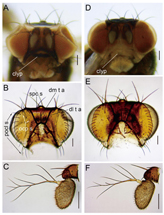Abstract
Hirtodrosophila fascipennis (Okada, 1967) and its closely related species, Hirtodrosophila pellucidipennis Bhardwaj, Khan & Fartyal, sp. nov., have been found in sympatry from Western Himalaya, India, and the latter is described here with detailed morphological comparison to the former. The most distinctive characteristic is that, while H. fascipennis has a distinct pattern of pigmentation on its wings, the new species lacks such wing pigmentation.
References
- Chen H.-Z. 1990. A preliminary survey on the taxonomy and ecology of Drosophila from East-China. Investigatio et Studium Naturae. Shanghai 8: 88–97. (In Chinese with English summary)
- Cumming J. M. & Wood D. M. 2017. Adult morphology and terminology, pp. 89–133. In: Manual of Afrotropical Diptera. Vol. 1 (A. H. Kirk-Spriggs and B. J. Sinclairs, editors). South African National Biodiversity Institute, Pretoria, 425 pp.
- Finet C., Kassner V. A., Carvalho A. B., Chung H., Day J. P., Day S., Delaney E. K., De Ré F. S., Dufour H. D., Dupim E., Izumitani H. F. Gautério T. B. Justen J., Katoh T., Kopp A., Koshikawa S., Longdon B., Loreto E. L., Nunes M. D. S., Raja K. K. B., Rebeiz M., Ritchie M. G., Saakayan G., Sneddon T., Teramoto M. T., Tyukmaeva V., Vanderlinde T., Wey E. E., Werner T., Williams T. M., Robe L. J., Toda M. J. & Marlétaz F. 2021. DrosoPhyla: Genomic resources for drosophilid phylogeny and systematics. Genome Biology and Evolution 13(8): evab179. https://doi.org/10.1093/gbe/evab179
- Grimaldi D. A. 1987. Phylogenetics and taxonomy of Zygothrica (Diptera: Drosophilidae). Bulletin of the American Museum of Natural History 186: 103–268.
- Grimaldi D. A. 2018. Hirtodrosophila of North America (Diptera: Drosophilidae). Bulletin of the American Museum of Natural History (421): 1–75. https://doi.org/10.1206/0003-0090-421.1.1
- Hadley A. 2010. Combine ZP software. Available from: https://combinezp.software. informer.com/ (Accessed 7 June 2022)
- Koshikawa S. 2020. Evolution of wing pigmentation in Drosophila: Diversity, physiological regulation, and cis-regulatory evolution. Development, Growth & Differentiation 62: 269–278. https://doi.org/10.1111/dgd.12661
- Massey J. H., Rice G. R., Firdaus A., Chen C. Y., Yeh S. D., Stern D. L. & Wittkopp P. J. 2020. Co-evolving wing spots and mating displays are genetically separable traits in Drosophila. Evolution 74(6): 1098–1111. https://doi.org/10.1111/evo.13990
- Okada T. 1967. A revision of the subgenus Hirtodrosophila of the old world with description of some new species and subspecies (Diptera: Drosophilidae). Mushi 41: 1–36.
- Okada T. 1976. New distribution records of the drosophilids in the Oriental Region. Makunagi (Acta Dipterologia) (8): 1–8. (In Japanese)
- Rice G., David J. R., Kamimura Y., Masly J. P., Mcgregor A. P., Nagy O., Noselli S., Nunes M. D. S., O’grady P., Sanchez-Herrero E., Siegal M. L., Toda M. J., Rebeiz M., Courtier-Orgogozo V. & Yassin A. 2019. A standardized nomenclature and atlas of the male terminalia of Drosophila melanogaster. Fly (Austin) 13: 51–64. https://doi.org/10.1080/19336934.2019.1653733
- Singh O. P. & Gupta J. P. 1981. New records and new species of Drosophila (Diptera: Drosophilidae) from India. Oriental Insects 15: 207–214. https://doi.org/10.1080/00305316.1981.10434857
- Toda M. J. 2022. DrosWLD-Species: Taxonomic Information Database for World Species of Drosophilidae. Available from: http://bioinfo.museum.hokudai.ac.jp/db/modules/stdb/index.php?ml_lang=en (Accessed on 7 June 2022).
- Zhang W.-X., Chen H.-Z., Peng T.-X. & Lin F.-J. 1996. Drosophilidae, pp. 280–414. In: Flies of China. Vol. 1 (W. Xue and C. Chao editors). Liaoning Science and Technology Press, Shenyang, 1365 pp.
- Zhang W.-X. & Toda M. J. 1992. A new species-subgroup of the Drosophila immigrans species-group (Diptera, Drosophilidae), with description of two new species from China and revision of taxonomic terminology. Japanese Journal of Entomology 60: 839‒850.
- Zhang Y., Katoh T. K., Finet C., Izumitani H. F., Toda M. J., Watabe H. & Katoh T. 2021. Phylogeny and evolution of mycophagy in the Zygothrica genus group (Diptera: Drosophilidae). Molecular Phylogenetics and Evolution 163: 107257. https://doi.org/10.1016/j.ympev.2021.107257


